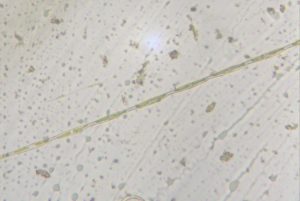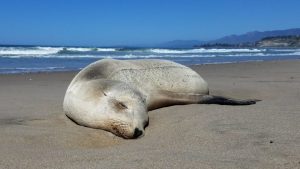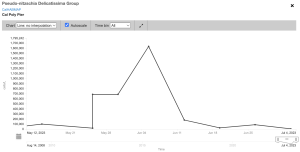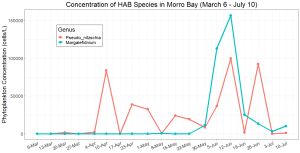Oceans are complex systems that provide many benefits to people and wildlife. But sometimes oceanic conditions occur that can cause harm to coastal communities and ecosystems. For the past two months, ocean monitoring organizations like NOAA CoastWatch and Southern California Coastal Ocean Observing System (SCCOOS) have been tracking harmful algae blooms off the central to southern California coast. Harmful algae blooms (HABs) occur when microscopic algae grow out of control and produce toxins that can impact humans and marine mammals.
What Causes HABs?
On the west coast, HABs often occur naturally due to ocean upwelling when deep, nutrient-rich water comes up to the surface and is exposed to sunlight, creating the perfect conditions for algae to grow. However HABs can become more frequent and intense due to higher ocean temperatures from climate change, El Niño events, and nutrients from stormwater and agriculture runoff.

HABs Impacts on Marine and Human Health
HABs can pose a threat to human health and local marine life, especially marine mammals and sea birds exposed to high concentrations of the neurotoxin domoic acid (DA) that is produced by the algae Pseudo-nitzschia. In California, the species Pseudo-nitzschia australis and Pseudo-nitzschia multiseries are the main toxin producers. The toxic algae do not affect filter feeders, such as small fish, shellfish, and bivalves that feed on the algae, but the toxin does affect the organisms that eat the filter feeders. The California Department of Public Health issues advisories when DA concentrations are high enough in shellfish and bivalves to cause food poisoning and other negative symptoms in humans.
Unfortunately for marine mammals, they don’t have any warning of when it is safe to eat their prey. The more contaminated prey the marine mammal consumes, the more likely it is for DA toxicosis to occur. Signs and symptoms DA toxicosis include disorientation, unresponsiveness, seizures, and even death if they continue to consume the toxin and do not receive treatment.

In the first half of June, particularly high concentrations of DA off the Santa Barbara Channel resulted in increased strandings of dolphins and California sea lions. A stranding is when a marine mammal is on shore and unable to return to the water on its own, is in need of medical attention, or is dead on the beach or in the water. The Channel Islands Marine & Wildlife Institute (CIMWI) co-founder and Managing Director Ruth Dover reported to NOAA Fisheries that they were receiving around 200 stranding reports a day between June 8 and 14. This may be one of the highest stranding events in the past twenty years.
Harmful Algae Blooms and Morro Bay
We are currently finding the smaller (and typically less toxic) species of algae called Pseudo-nitzschia delicatissima in the local waters in Morro Bay and the Cal Poly Pier. The dominant plankton in the water is currently a toxic dinoflagellate that can cause mortality events of finfish and shellfish. Alexandrium spp. was also present in the past weeks’ plankton monitoring, which can cause a neurotoxin to build up in shellfish that leads to paralytic shellfish poisoning in humans if high concentrations are consumed.

What are some of the resources for tracking HABs?
- The CDPH will issue shellfish advisories if DA is present in shellfish in your area. See their interactive map for toxic phytoplankton observations.
- You can track harmful algae blooms using the California-Harmful Algae Risk Mapping (C-HARM) tool that forecasts DA toxin levels and Pseudo-nitzschia abundance in coastal waters by using ocean circulation models and satellite imagery. C-HARM allows you to zoom in to your area of the coast to find Pseudo-nitzschia, particulate, and cellular DA concentrations.
- Southern California Coastal Ocean Observing System (SCCOOS) has numerous Ocean Observation Stations that track harmful algae blooms and other parameters like water temperature, salinity, and oxygen. The closest SCCOOS HAB monitoring site to Morro Bay is at the Cal Poly Pier in Avila Beach.
- You can subscribe to the SCCOOS CA HAB Bulletin listserv for a monthly update of all things HAB related in the state.
- Cal Poly conducts weekly phytoplankton sampling within Morro Bay as part of a collaborative project with the Estuary Program.
What can I do to help?
If you’re out enjoying the beach and encounter a stranded marine mammal, here are some tips:
- Stay at least 50 feet away from stranded animals (keep pets away too!) and contact the proper agency for assistance. If you are in a county other than San Luis Obispo, you can find your contact number for marine mammal strandings here.
- Within San Luis Obispo County:
- For deceased whales and dolphins, contact the Channel Island Cetacean Research Unit at (805) 896-0858.
- For stranded sea lions, dolphins, and other marine mammals, contact the West Coast Region Stranding Hotline at (866) 767-6114 or The Marine Mammal Center at (415) 289-7325.
- You can also contact the Morro Bay Harbor Patrol for any marine mammal concerns at (805) 772-6254.
Help us protect and restore the Morro Bay estuary!
- Donate to the Estuary Program today and support our work in the field, the lab, and beyond.
The Estuary Program is a 501(c)3 nonprofit. We depend on funding from grants and generous donors to continue our work. - Support us by purchasing estuary-themed gear from ESTERO. This locally owned and operated company donates 20% of proceeds from its Estuary clothing line and 100% of Estuary decal proceeds to the Estuary Program. Thank you, ESTERO!
- Purchase items from the Estuary Program’s store on Zazzle. Zazzle prints and ships your items, and the Estuary Program receives 10% of the proceeds. Choose from mugs, hats, t-shirts, and even fanny packs (they’re back!) with our fun Estuary Octopus design, our classic Estuary Program logo, or our Mutts for the Bay logo.
- We want to hear from you! Please take a few minutes to fill out this short survey about what type of events you’d like to see from the Estuary Program. We appreciate your input!
Thank you for helping our beautiful, bountiful, biodiverse bay!
